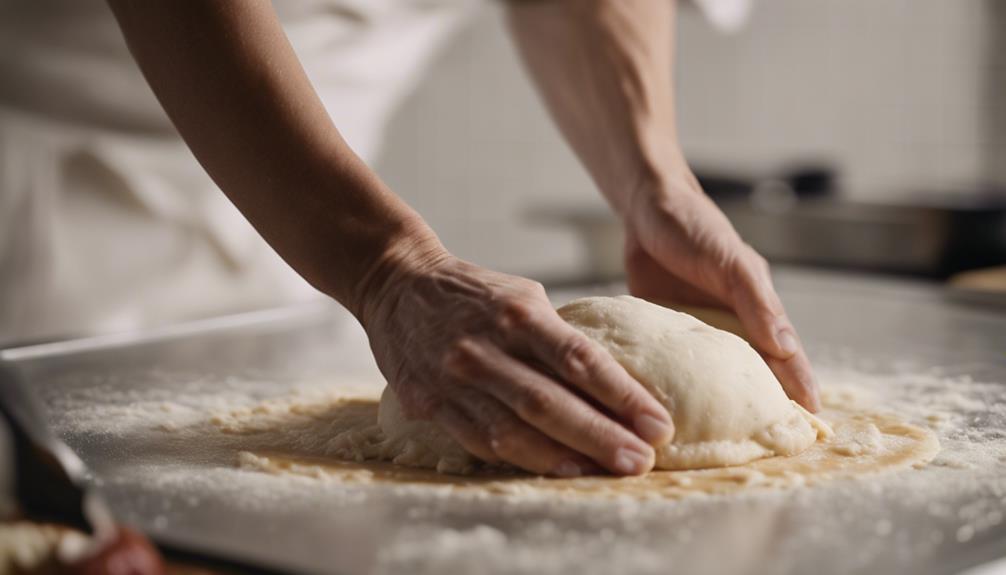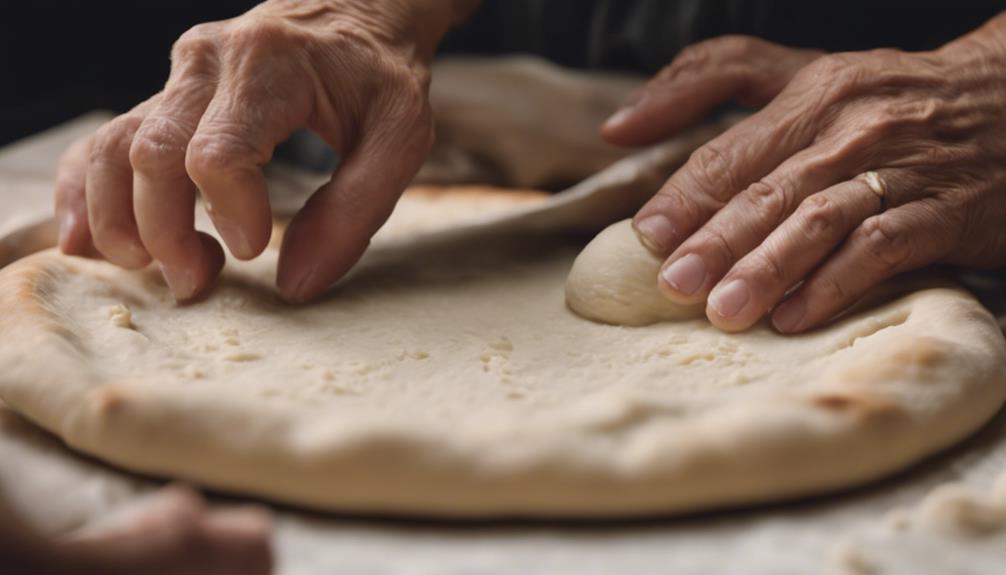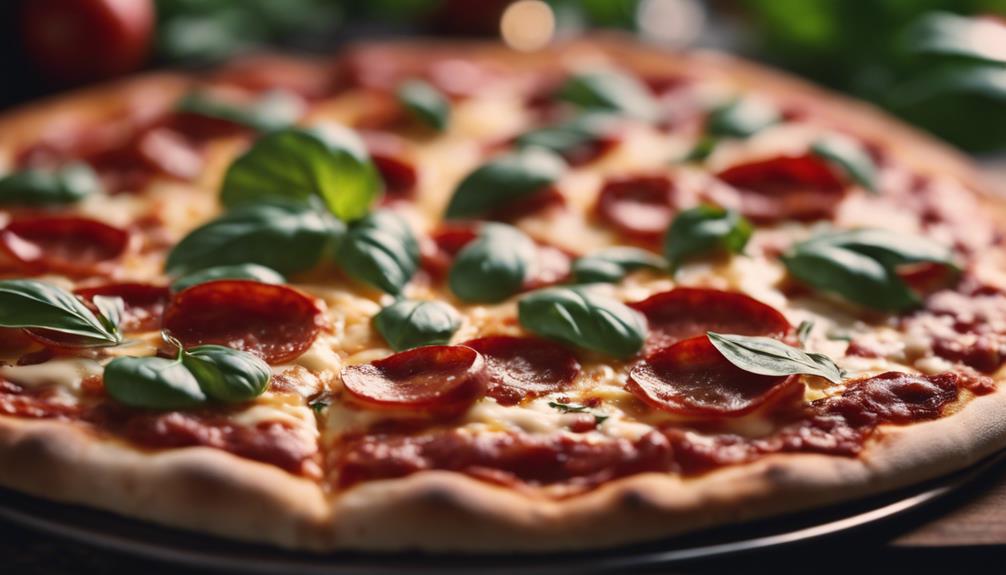When it comes to pizza dough, you may have tried various recipes, but Nancy Silverton's version offers a distinct approach that sets it apart. The meticulous attention to detail in ingredient selection and the methodical process of fermentation result in a dough that promises a unique culinary experience. Before you know it, you'll be on a journey to uncover the secrets behind achieving that perfect balance of texture and flavor that will elevate your homemade pizza to a whole new level.
Key Takeaways
- Optimal hydration levels for desired dough texture.
- Experiment with various flour types for custom flavor.
- Ensure yeast activation before combining ingredients.
- Prolonged fermentation enhances dough flavor.
- Gentle shaping techniques for perfect pizza crust.
Ingredients for Nancy Silverton Pizza Dough

When making Nancy Silverton's pizza dough, you'll want to gather high-quality ingredients to guarantee a delicious and authentic taste. The first step is to ponder the hydration levels of your dough. Adjusting the amount of water used can greatly impact the texture and chewiness of the final crust. Experiment with different flour types to find the perfect balance between a crispy exterior and a soft interior.
Ensure your yeast is properly activated before incorporating it into the dough. This step is vital for achieving that airy and light texture in your pizza crust. Once the dough is mixed, allow it to ferment slowly. This process develops the flavors and creates a complex taste profile in the finished product. The longer the fermentation period, the more depth of flavor your pizza dough will have.
Mixing the Dough
To mix the Nancy Silverton pizza dough, begin by combining the flour, yeast, salt, and water in a large bowl. The essential mixing method is crucial for achieving the perfect dough consistency. Using a wooden spoon or your hands, gently stir the ingredients together until a shaggy dough forms. It's important not to overmix at this stage; a few lumps are okay.
The dough consistency should be slightly sticky but not too wet. If it feels too dry, add a little more water, a tablespoon at a time. On the other hand, if it's too wet, sprinkle in a bit more flour until you reach the desired texture. The key is finding the balance that will result in a smooth and elastic dough that holds together well.
Kneading Technique

Engage your hands to work the dough, applying steady pressure to develop gluten strands and achieve the desired elasticity for Nancy Silverton's pizza dough recipe. Proper kneading is essential for creating a dough that's just right – not too sticky nor too dry.
Here are some essential tips for mastering the kneading technique:
- Consistency Check: Pay attention to the texture of the dough as you knead. It should gradually transform from a shaggy mass to a smooth and slightly tacky ball.
- Time Matters: Kneading isn't a rush job. Take your time to allow the gluten to develop fully. This process usually takes around 8-10 minutes of continuous kneading.
- Feel the Dough: Don't rely solely on the recipe's suggested kneading time. Instead, trust your hands and the dough's consistency. Adjust the kneading duration based on how the dough feels under your touch.
Dough Resting Period
For best results, allow the pizza dough to rest after kneading to relax the gluten strands and enhance the dough's texture. This resting period is of utmost importance in the pizza-making process. After kneading, cover the dough and let it rest at room temperature for a specific fermentation period. This resting time allows the dough to relax, making it easier to shape and stretch later on.
During the fermentation period, the yeast in the dough becomes active, leading to the development of flavors and textures. This process adds depth and complexity to your pizza crust, creating a more delicious final product. The dough will also rise slightly during this time, giving it a light and airy quality once baked.
Shaping and Stretching

When shaping and stretching the pizza dough, focus on maintaining an even thickness throughout to guarantee a balanced crust. To achieve the perfect pizza base, consider the following shaping techniques and stretching tips:
- Gentle Pressure: Apply gentle and consistent pressure when shaping the dough to prevent tearing and ensure an even distribution of thickness.
- Hand Stretching: Use your hands to stretch the dough gradually from the center outwards, rotating it as you go to maintain an even round shape.
- Avoid Overworking: Be careful not to overwork the dough during shaping and stretching as this can lead to a tough crust. Handle it delicately to maintain its light and airy texture.
Baking Instructions
Maintain the even thickness you achieved while shaping and stretching as you move on to the baking instructions for the perfect Nancy Silverton pizza crust. Preheat your oven to 500°F (260°C) with a pizza stone inside, allowing it to heat for at least 30 minutes. The intense heat from the stone helps create that crispy, delicious crust we all love.
When your oven and pizza stone are properly preheated, it's time to slide your pizza onto the stone. Be cautious as it's hot! Bake the pizza for about 8-10 minutes, but keep a close eye on it. You want the crust to be a beautiful golden brown color.
To make sure your pizza turns out just right, here are some baking tips: make sure the oven temperature is high enough for that perfect bake, and pay attention to the dough texture when shaping it – not too thin or thick. Also, make sure your yeast is properly activated for that lovely rise in the crust. Now, get ready to enjoy your homemade Nancy Silverton pizza straight from the oven!
Final Pizza Assembly and Enjoyment

Once the pizza is baked to perfection, garnish it with your favorite toppings and savor every delicious bite. Whether you prefer classic pepperoni, fresh veggies, or gourmet cheeses, the choice is yours to make each slice uniquely yours. Let your creativity shine as you adorn the golden crust with a colorful array of pizza toppings.
- Freshness Guaranteed: Using high-quality ingredients guarantees a burst of flavors in every mouthful.
- Balance is Key: Experiment with a variety of toppings to achieve the perfect harmony of tastes and textures.
- Wine Pairing: Enhance your pizza experience by pairing it with a glass of your favorite wine. A light Pinot Noir complements a mushroom and truffle pizza, while a crisp Sauvignon Blanc can elevate a classic Margherita.
As you gather around the table with friends and family, raise a toast to good food and great company. The culmination of your efforts isn't just a meal but a shared moment of joy and connection.
Conclusion
To sum up, Nancy Silverton's pizza dough recipe is a perfect blend of simplicity and sophistication. With just a few key ingredients and careful techniques, you can create a delicious pizza crust that's crispy on the outside and chewy on the inside.
So gather your favorite toppings, fire up the oven, and get ready to enjoy a homemade pizza that will impress your taste buds and loved ones alike. Happy baking!

